Related Research Articles
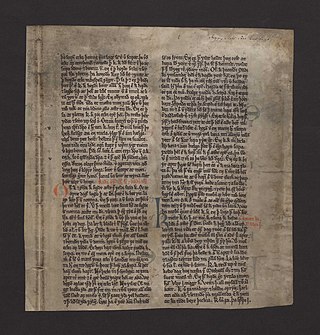
Heimskringla is the best known of the Old Norse kings' sagas. It was written in Old Norse in Iceland by the poet and historian Snorri Sturluson (1178/79–1241) c. 1230. The name Heimskringla was first used in the 17th century, derived from the first two words of one of the manuscripts.

The Norns are deities in Norse mythology responsible for shaping the course of human destinies.
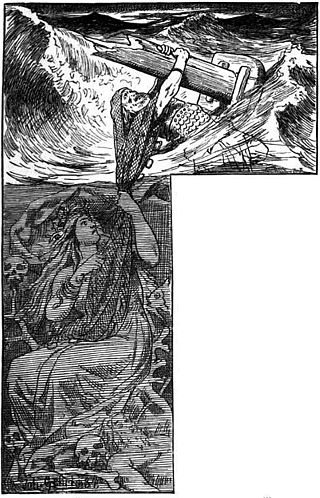
For the star called Rán, see Epsilon Eridani.

The sagas of Icelanders, also known as family sagas, are one genre of Icelandic sagas. They are prose narratives mostly based on historical events that mostly took place in Iceland in the ninth, tenth, and early eleventh centuries, during the so-called Saga Age. They were written in Old Icelandic, a western dialect of Old Norse. They are the best-known specimens of Icelandic literature.
In Norse mythology, Snotra is a goddess associated with wisdom. Snotra is attested in the Prose Edda, written in the 13th century by Snorri Sturluson, and in the Gautreks Saga, where she is the mother of Gautrek son of Gauti, the eponymous ancestor of the Geats, and Goths, a son of Oðinn as King of Sviþjoð. Scholars have proposed theories about the implications of the goddess.

The Poetic Edda is the modern name for an untitled collection of Old Norse anonymous narrative poems, which is distinct from the Prose Edda written by Snorri Sturluson, although both works are seminal to the study of Old Norse poetry. Several versions of the Poetic Edda exist: especially notable is the medieval Icelandic manuscript Codex Regius, which contains 31 poems. The Codex Regius is arguably the most important extant source on Norse mythology and Germanic heroic legends. Since the early 19th century, it has had a powerful influence on Scandinavian literature, not only through its stories, but also through the visionary force and the dramatic quality of many of the poems. It has also been an inspiration for later innovations in poetic meter, particularly in Nordic languages, with its use of terse, stress-based metrical schemes that lack final rhymes, instead focusing on alliterative devices and strongly concentrated imagery. Poets who have acknowledged their debt to the Codex Regius include Vilhelm Ekelund, August Strindberg, J. R. R. Tolkien, Ezra Pound, Jorge Luis Borges, and Karin Boye.
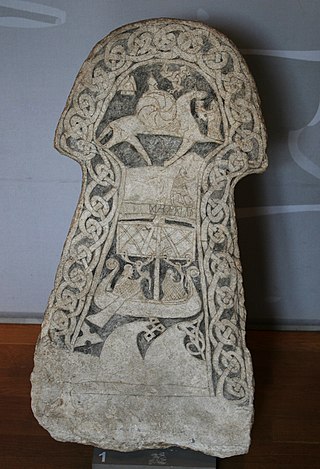
In Norse mythology, a valkyrie is one of a host of female figures who guide souls of the dead to the god Odin's hall Valhalla. There, the deceased warriors become einherjar. When the einherjar are not preparing for the events of Ragnarök, the valkyries bear them mead. Valkyries also appear as lovers of heroes and other mortals, where they are sometimes described as the daughters of royalty, sometimes accompanied by ravens and sometimes connected to swans or horses.

Skírnismál is one of the poems of the Poetic Edda. It is preserved in the 13th-century manuscripts Codex Regius and AM 748 I 4to but may have been originally composed in the early 10th century. Many scholars believe that the poem was acted out, perhaps in a sort of hiéros gamos.
In Norse mythology, Dellingr is a god. Dellingr is attested in the Poetic Edda, compiled in the 13th century from earlier traditional sources, and in the Prose Edda, written in the 13th century by Snorri Sturluson. In both sources, Dellingr is described as the father of Dagr, the personified day. The Prose Edda adds that, depending on manuscript variation, he is either the third husband of Nótt, the personified night, or the husband of Jörð, the personified earth. Dellingr is also attested in the legendary saga Hervarar saga ok Heiðreks. Scholars have proposed that Dellingr is the personified dawn and his name may appear both in an English surname and place name.
Sagas are prose stories and histories, composed in Iceland and to a lesser extent elsewhere in Scandinavia.
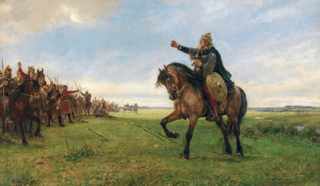
Hervarar saga ok Heiðreks is a legendary saga from the 13th century combining matter from several older sagas in Germanic heroic legend. It tells of wars between the Goths and the Huns during the 4th century. The final part of the saga, which was likely composed separately from and later than the rest, is a source for Swedish medieval history.
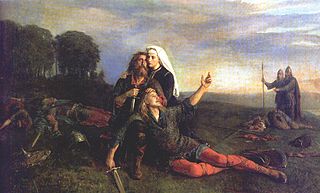
A legendary saga or fornaldarsaga is a Norse saga that, unlike the Icelanders' sagas, takes place before the settlement of Iceland. There are some exceptions, such as Yngvars saga víðförla, which takes place in the 11th century. The sagas were probably all written in Iceland, from about the middle of the 13th century to about 1400, although it is possible that some may be of a later date, such as Hrólfs saga kraka.

Hervararkviða, is an Old Norse poem from the Hervarar saga, and which is sometimes included in editions of the Poetic Edda.
Icelandic literature refers to literature written in Iceland or by Icelandic people. It is best known for the sagas written in medieval times, starting in the 13th century. As Icelandic and Old Norse are almost the same, and because Icelandic works constitute most of Old Norse literature, Old Norse literature is often wrongly considered a subset of Icelandic literature. However, works by Norwegians are present in the standard reader Sýnisbók íslenzkra bókmennta til miðrar átjándu aldar, compiled by Sigurður Nordal on the grounds that the language was the same.

In Norse mythology, Sága is a goddess associated with the location Sökkvabekkr. At Sökkvabekkr, Sága and the god Odin merrily drink as cool waves flow. Both Sága and Sökkvabekkr are attested in the Poetic Edda, compiled in the 13th century from earlier traditional sources, and in the Prose Edda, written in the 13th century by Snorri Sturluson. Scholars have proposed theories about the implications of the goddess and her associated location, including that the location may be connected to the goddess Frigg's fen residence Fensalir and that Sága may be another name for Frigg.

Norse, Nordic, or Scandinavian mythology is the body of myths belonging to the North Germanic peoples, stemming from Old Norse religion and continuing after the Christianization of Scandinavia, and into the Nordic folklore of the modern period. The northernmost extension of Germanic mythology and stemming from Proto-Germanic folklore, Norse mythology consists of tales of various deities, beings, and heroes derived from numerous sources from both before and after the pagan period, including medieval manuscripts, archaeological representations, and folk tradition. The source texts mention numerous gods such as the thunder-god Thor, the raven-flanked god Odin, the goddess Freyja, and numerous other deities.
Ljótólfr is a minor character in the mediaeval Orkneyinga saga, who is purported to have flourished in the mid-12th century. The Orkneyinga saga was compiled in about 1200, and documents the reigns of the earls of Orkney. It depicts Ljótólfr as a nobleman who lived on the Outer Hebridean Isle of Lewis. During the 12th century, the Hebrides formed part of the Kingdom of Mann and the Isles.

Germanic heroic legend is the heroic literary tradition of the Germanic-speaking peoples, most of which originates or is set in the Migration Period. Stories from this time period, to which others were added later, were transmitted orally, traveled widely among the Germanic speaking peoples, and were known in many variants. These legends typically reworked historical events or personages in the manner of oral poetry, forming a heroic age. Heroes in these legends often display a heroic ethos emphasizing honor, glory, and loyalty above other concerns. Like Germanic mythology, heroic legend is a genre of Germanic folklore.
In Norse mythology, the sister-wife of Njörðr is the unnamed wife and sister of the god Njörðr, with whom he is described as having had the twin children Freyr and Freyja. This shadowy goddess is attested in the Poetic Edda poem Lokasenna, recorded in the 13th century by an unknown source, and the Heimskringla book Ynglinga saga, a euhemerized account of the Norse gods composed by Snorri Sturluson also in the 13th century but based on earlier traditional material. The figure receives no further mention in Old Norse texts.
Ormars rímur is a fifteenth-century Icelandic ríma-cycle, relating how Ormarr Fraðmarsson slays the giant Bjarkmar and his uncles Gyrðr and Atli. In doing so, Ormarr avenges his father and wins a bride and kingdom.
References
- 1 2 3 Ohlmarks, Åke. (1982). Fornnordiskt lexikon. Tiden. ISBN 91-550-2511-0.
- ↑ Kapitan, Katarzyna Anna and Lavender, Philip, 'The Prose Summary as Antiquarian Tool and Literary Springboard: An Edition and Translation of Ormars þáttur Framarsonar', Opuscula, 20 (2022), pp. 101–60.